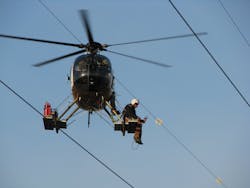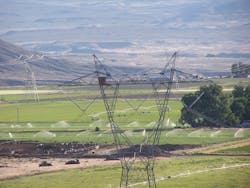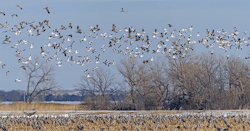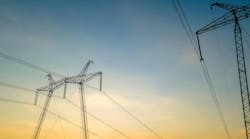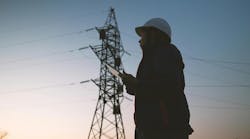Since the first power lines were constructed in the early 1900s, birds have used the wires and poles as places to perch, hunt for prey or even build a nest. Although it may sound harmless, the reality is that power poles and overhead lines pose a serious risk to avian species.
In fact, bird collisions with telegraph lines were first reported in 1876. But in 1936, the Rural Electrification Act brought electricity to rural areas and greatly increased the amount of power lines in the country. While the Migratory Bird Treaty Act (MBTA) was established in 1918, it wasn’t until the 1970s that scientists and wildlife managers began paying attention to the extent of the impact power lines have on avian species.
Since that time, the utility industry, wildlife resource agencies, conservation groups and manufacturers of avian protection products have worked together to better understand the various interactions between birds and power lines.
As communities continue to grow and the demand for electricity increases, so does the need to understand avian safety and implement environmental regulations that successfully protect birds.
Regulatory Protection and APLIC
Three main federal regulations protect almost all native avian species. The Endangered Species Act applies to species that are federally listed as threatened or endangered. As the name implies, the Bald and Golden Eagle Protection Act provides additional protection to both bald and golden eagles.
First established between the U.S. and Canada in 1918, the MBTA has since expanded to include Mexico, Japan and Russia, and currently protects 1,093 North American migratory bird species.
On January 7, 2021, the U.S. Fish and Wildlife Service (USFWS) published a final rule regarding “take” prohibitions under the MBTA, stating that incidental take is not excluded under the law. The January 7 final rule was formally revoked on October 4, 2021. Currently, incidental take is considered a violation of the MBTA. This means that, under the MBTA, birds dying by electrocution or collision with power lines, wind turbines, buildings, cars and the loss of nests during construction activities are considered a take.
In conjunction with regulatory protections, the Avian Power Line Interaction Committee (APLIC) was formed in the 1980s when 14 whooping cranes—one of the most imperiled bird species in the U.S.—were injured or killed colliding with power lines. A flagship species of the ESA, the whooping crane fatalities prompted action from the USFWS, Edison Electric Institute, Audubon Society and 10 electric utilities to form the committee.
Today, APLIC has expanded to include the National Rural Cooperative Electrical Association and over 70 member utilities. The committee works in partnership with resources agencies, the public and utility companies to develop and provide educational resources to minimize incidents of avian electrocutions and collisions.
Common Causes of Avian Injury or Death
Avian electrocution is a frequent concern raised by state and federal wildlife managers as they consider power line projects under their jurisdiction. Birds can be electrocuted on power lines if they span the gap between two energized conductors or an energized portion of a line and a grounded portion of a line. While this is a concern on distribution lines, transmission lines rarely cause avian electrocution due to the larger spacing between conductors.
Avian collision with conductors and shield wires is another power line risk for birds. Several factors come into play when examining avian collision: bird physiology, activity of birds, climate, placement of power lines and design configuration, to name a few.
The ratio of a bird’s wing size to its mass is called wing loading. Collision is more common in species with high wing loading—smaller wings and heavier bodies. Birds in this category—cranes, waterfowl and grouse—are typically more susceptible to avian collision, given their low in-flight maneuverability.
Certain bird activities such as traveling in large flocks, actively chasing prey or engaging in mating displays can increase rates of avian collision, as can inclement weather like fog or other low-light conditions.
Conductor Spacing and Insulators
There are a few simple measures that reduce the threat of avian electrocution. First, considering the conductor spacing during design. APLIC’s Suggested Practices for Avian Protection on Power Lines: The State of the Art in 2006 provides design standards for numerous conductor configurations.
Generally, the guideline for preventing electrocution is by maintaining 60 inches of horizontal spacing and 40 inches of vertical spacing between conductors. These measurements are based on the size of a golden eagle, which is the largest bird in North America, with the exception of the rare California condor. When vertical and horizontal spacing cannot be achieved, conductor insulators can be installed to minimize electrocution risk.
Routing/Siting and Shield Wires
Because birds frequently pass between areas for roosting, nesting and feeding, power lines that bisect these areas increase the risk of avian collision. The routing and siting of power lines plays a significant role in the reduction of avian collisions, as lines placed near high-concentration avian areas, such as known migration corridors or night roosts, present a greater risk of avian collision.
The shield wire, typically placed above transmission lines, presents a higher risk of collision than the larger diameter conductor wires below. Birds may see the larger conductors and gain altitude to pass them over, only to collide with the narrower and less visible shield wire.
While very rare in practice, certain transmission line spans, such as those over large river crossings, have been designed without an overhead shield wire to reduce the risk of avian collision. This is uncommon, however, as overhead shield wires protect the conductors from lightning strikes and often include a fiber-optic communication cable.
Line Marking
The most common avoidance measure to reduce avian collision is line marking, achieved through the use of bird flight diverters. APLIC’s Reducing Avian Collisions with Power Lines: The State of the Art in 2012 provides guidance on bird flight diverter application, spacing and effectiveness.
Numerous bird flight diverter designs are commercially available, each with its own application method and spacing recommendations. Bird flight diverter designs vary greatly. Some include swinging plates that provide visible motion, some use durable static coils with no moving parts, and others feature easy-to-install clip-on devices.
Birds and Power Lines Can Coexist
Despite varying designs, the functional goal for each bird flight diverter is the same—to increase line visibility. Birds approaching a power line should see the bird flight diverters, gain altitude to avoid collision and pass safely overhead.
An understanding of avian interactions with power lines is a complex but necessary topic to help utility companies and birds successfully coexist. From effective routing and siting to power line design and spacing and the addition of bird flight diverters, each component plays a role in reducing avian loss or preventing adverse impact. These precautions ultimately benefit the birds, power utilities, their customers and the ecosystem.
Ben Bainbridge is a Certified Wildlife Biologist with experience in laboratory and field research with mammal, avian and amphibian species, plant species, wetlands and silviculture. He has experience in population surveys for federal- and state-listed special status species and condition assessment of their habitats. Ben has a clear understanding of the requirements and processes of the National Environmental Policy Act and has applied these principles to field research and the permitting of electrical transmission projects.

